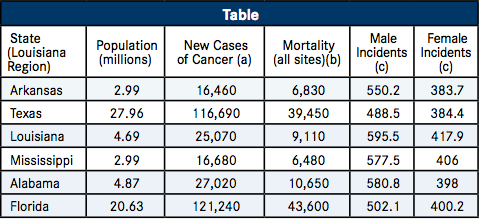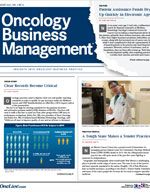Publication
Article
Oncology Business News®
Insured Patients Flock to Mobile Clinic
Author(s):
Louisiana leads the nation in cancer mortality—and not in the good sense. The state’s cancer mortality rate is 14% higher than the national average. Much of the problem lies in late diagnosis. Louisiana residents are less likely than other Americans to undergo recommended screenings, so their tumors tend to be more advanced upon detection.
Sandra Holub

Sandra Holub
Louisiana leads the nation in cancer mortality—and not in the good sense. The state’s cancer mortality rate is 14% higher than the national average. Much of the problem lies in late diagnosis. Louisiana residents are less likely than other Americans to undergo recommended screenings, so their tumors tend to be more advanced upon detection.
The Mary Bird Perkins Our Lady of the Lake Cancer Center in Baton Rouge has been working to change that by bringing free screening services directly to people where they live and work. The cancer center began in 2002 by driving its mobile clinic to communities where many residents are uninsured or underinsured. Now, it is supplementing that successful program with a new pilot that brings free screenings someplace even more unexpected: to local workplaces that insure many employees.
Sandra Holub, executive director of the Albemarle Foundation, a local philanthropy organization funding the new effort, believes the mobile clinic can help to increase early detection in populations that don’t get regular screening. “I have great insurance. I know exactly what I should be doing, yet I’ve never taken the time to get a skin screening, and I’m not alone. Research indicates that most fully insured people fail to follow American Cancer Society screening guidelines, and that’s why this is such an important program,” she said.
Officials hypothesized that Louisiana’s high cancer mortality rates would mean that the state had equally high incidence rates. The general lifestyle of the state’s population supported that assumption. Louisiana’s residents are more likely than Americans, as a whole, to smoke tobacco, drink alcohol, and put on weight. They also spend an unusual amount of time outside, under an intense southern sun. It turned out, however, that Louisiana’s cancer incidence rates are about average and that researchers needed to look elsewhere to explain what’s causing the high mortality rates (Table).
Researchers at the Louisiana Tumor Registry placed much of the blame on the state’s unusually low screening rates. Officials at the Baton Rouge cancer center responded to those findings by looking for ways to boost screening in communities where it was lowest: poor communities that housed many of the 23% of all state residents who, at the time, lacked insurance. In 2002, the cancer center’s mobile screening center rolled out of the driveway for the first time.
Since then, the healthcare workers who staff the mobile clinic have set up shop in the parking lots of churches, shopping centers, government offices, barbershops, and any other place that might attract new patients. They have screened more than 74,000 people, so far, and detected more than 500 cancers.
“The program has been more effective than we dared to hope when we launched it, not only because we’ve educated and screened so many people who would not have otherwise had access to these services, but also because we have detected so many cancers. Our detection rate is roughly twice what you’d expect from a truly random patient population, so clearly we are serving a population that really needs to be served,” said cancer center President and CEO Todd Stevens.
It turned out, however, that uninsured people weren’t the only ones who needed service. Fully insured people showed up at the mobile screening center almost from the start and grew into a significant percentage of all the patients who visit.
“These insured individuals told us they didn’t have time to miss work and make a special trip for screening, but they decided to come when they saw our mobile clinic someplace they already visit for other reasons,” Stevens said. “Eventually, we started exploring ideas to bring information about cancer, cancer prevention, and access to primary screening into the workplace.”
Cancer center officials investigated the concept from many angles. They looked at the research and found that significant percentages of full-time workers skip recommended screenings. They surveyed employees at local companies and heard that many workers who missed screenings would consider taking advantage of a cancer-related program in the workplace. Then, they went in search of donors to fund it.
They soon came to the Albemarle Foundation, a local philanthropy that’s largely funded by the specialty chemical company Albemarle Corp and its thousands of employees. Both the foundation and the corporation have longstanding ties to the Baton Rouge center, and they soon became intrigued by the idea of workplace cancer screenings.
Indeed, Albemarle Corp CEO Luke Kissam had already been working to bring wellness programs to his company, and he had immediate ideas about how a cancer-prevention program could expand awareness, increase screening, and otherwise protect workers from the disease. Albemarle Corp quickly agreed to participate in the pilot program, which also signed up four other organizations. The Albemarle Foundation, meanwhile, committed $200,000 a year for five years to get the initiative started.
The Baton Rouge center hired a local consulting company to help develop an office-oriented version of its existing mobile education-and-screening program. Then, in early September, the first of a handful of test sessions took place at a mid-sized company called Lipsey’s. This initial effort drew more workers than even the program’s biggest supporters could have anticipated: more than half of all the employees in the facility came to the educational presentation that constituted the first part of the visit.
The cancer center focused that presentation on skin cancer. It then followed up a week later by providing employees total body skin examinations (recommended on an annual basis for all Americans ages 20 and above).
“We focused the educational session on skin cancer because we see it as major area for potential improvement,” said Renea Duffin, vice president for cancer support and outreach at the Baton Rouge center. “Most people don’t realize how common [cancer] is or that they’re supposed to have yearly exams, or even how much sunscreen they’re supposed to use. A few people knew the proper quantity of sunscreen is ‘enough to fill a shot glass,’ but when we actually passed a shot glass filled with sunscreen around the crowd, even they were pretty surprised to see how much sunscreen I was really talking about.”
Table

The team measured the presentation’s efficacy by comparing what workers knew about skin cancer before Duffin began and after she finished. The final results showed major improvement, but the presentation is still a work in progress. Duffin and her team will try to hone it as she moves through the program’s pilot phase, and cancer center officials will talk to employers about what type of screening they want to make available to employees.
“We can bring the personnel and equipment we need to do far more screenings. The outreach program we’ve run since 2002 now includes mammography and digital rectal exams for prostate cancer, as well as tests for prostate-specific antigen. It’s really just a matter of what the employers who take part in this program want,” Duffin said. “Still, even though we only offered dermatological screenings at the first event, we referred seven of the 56 participants we screened to their local physician for further evaluation (a biopsy). That's a significant figure for an afternoon, particularly because none of these individuals had immediate plans to get screened before we came along."
Although the corporate outreach program is currently supported by grant money, Stevens believes that it could eventually be supported by payers or employers themselves. Many employers already offer on-site wellness programs that focus on preventing or at least minimizing chronic conditions such as diabetes. Research has found that these programs reduce employee medical costs and increase employee productivity, so employers, payers (or some combination of both) foot the bill.
If the cancer screening program attracts workers and detects cancers at rates that promise to do likewise, it should eventually grow from a tiny pilot program to a common fringe benefit, a benefit that could provide significant new work to dermatologists and oncologists who can establish themselves in the market.
“My guess is that if this program produces demonstrable benefits at the few firms where we start, then local employers will be willing to pay the costs we incur to bring it to their employees. Most employers realize that anything that benefits employee well-being is good for them,” Stevens said. “The insurance market is harder to predict. Some insurers have virtually no wellness programs. Others have put some very good wellness programs together. One way or another, if a service provides genuine value—and we really hope that increasing awareness of information and services to fight cancer will save a lot of lives—then it will be embraced.”










